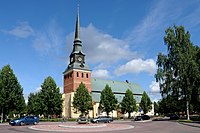
Mora is a locality and the seat of Mora Municipality in Dalarna County, Sweden, with 10,896 inhabitants in 2010.

Vittskövle Church is a church in Kristianstad Municipality, in Skåne, Sweden. It is part of the Diocese of Lund.

Saint Peter's Church is a Brick Gothic church in Malmö, Sweden. Built in the 14th century as the main church of the city, it has been described as "the main Gothic monument within church architecture in Scania". The church was a spiritual centre during the Reformation, and was one of only a few churches in what was at the time medieval Denmark that suffered damage due to iconoclasm as a consequence of the Reformation. St. Peter's Church contains late medieval murals of recognized high quality, as well as a number of unusual furnishings. The altarpiece, made in 1611, is one of the largest in the Nordic countries. The church is built as a basilica with three naves and transepts. The church is actually dedicated to two saints, St. Peter and St. Paul, Ecclesia beatorum Petri et Pauli apostolorum.

Börringe Priory, also known as Börringekloster Castle is a medieval Benedictine priory founded in 1150 at Svedala in Scania, Denmark. Secularized in 1536, the site was developed as a home for the Brahe family. The present large building, known as Börringeklosters slott, was built here in 1763.

The German Church, sometimes called St. Gertrude's Church, is a church in Gamla stan, the old town in central Stockholm, Sweden, belonging to the German Saint Gertrude Parish of the Church of Sweden.

Saint James's Church is a church in central Stockholm, Sweden, dedicated to apostle Saint James the Greater, patron saint of travellers. It is often mistakenly called St Jacob's. The confusion arises because Swedish, like many other languages, uses the same name for both James and Jacob.

The Church of Saint Mary Magdalene is a church on Södermalm in central Stockholm, Sweden, dedicated to and named for Jesus' companion Mary Magdalene.

St. Peter's Priory was one of Denmark's early monastic houses. It was located in Lund, Skåne, now southern Sweden, formerly part of Denmark.

Saint Eugenia's Church is a Roman Catholic church in the center of Stockholm (Sweden). It was built in 1982 on plans of the Danish architect Jørgen Kjaergaard and is situated next to the former Royal Gardens, Kungsträdgården in Norrmalm. The Church is consecrated to Saint Eugenia, an abbess (700-735) of the monastery Mont Sainte-Odile in Alsace (France).

St. Lawrence's Church is a medieval Lutheran church in Söderköping, Sweden. The original church was dedicated to Lawrence of Rome and the church retained its name also following the Reformation. It is located in central Söderköping and functions as a parish church within the Diocese of Linköping. It is one of two surviving medieval churches in Söderköping, the other being Drothem Church. Both churches are associated with the Diocese of Linköping of the Church of Sweden.

Falsterbo Church is a medieval Lutheran church at Falsterbo in Skåne County, Sweden.

Lärbro Church is a medieval church in Lärbro on the Swedish island of Gotland. The church is located at a former strategically important spot, as testified by the adjacent fortified tower. The presently visible Gothic church replaced an earlier Romanesque church during the 13th and 14th century. The cemetery of the church contains several graves of victims from Nazi concentration camps who were taken to a field hospital in Lärbro during and after World War II.

Frötuna Church is a medieval Lutheran church in the Archdiocese of Uppsala close to Norrtälje in Stockholm County, Sweden.

Skederid Church is a medieval church, which belongs to the Lutheran Archdiocese of Uppsala. It lies just outside Norrtälje in Stockholm County, Sweden. It was built by Birger Persson, father of Saint Bridget of Sweden, and it is probably the church where she was baptised.

Ed Church is a Lutheran church about 3 km southwest of the centre of Upplands Väsby, Stockholm County, Sweden. It belongs to the Diocese of Stockholm. It is a listed building, protected by law.
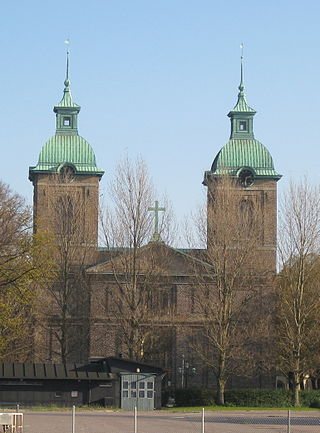
Sofia Albertina Church is the main church in Landskrona, Sweden. Belonging to the Landskrona Parish of the Church of Sweden, it was inaugurated in 1788 and fully completed in 1816. It is considered a rare church building, in the respect that it has two towers without being a Bishop's church. The church was originally designed by Carl Hårleman, as perhaps his last greater task. Hårleman died in 1753, the same year as the old church was demolished. Smaller changes to Hårlemans original may have been done.
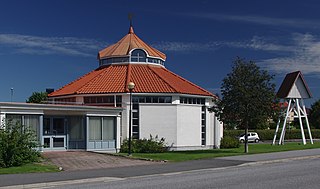
Saint John's Church is a church building in Habo in Sweden. Belonging to the Habo Parish of the Church of Sweden, it was inaugurated on 12 September 1993.

The Saint Sava Serbian Orthodox Church is a church building in Enskede gård in Stockholm, Sweden. It was taken into use in 1991 but not officially inaugurated until 5 October 2014. It is the cathedral church of the Serbian Orthodox Eparchy of Britain and Scandinavia.
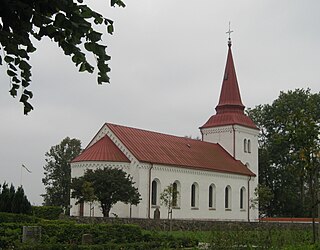
The Östra Torp Church is a church building in Smygehamn, Sweden. Belonging to the Källtorp Parish of the Church of Sweden, it inaugurated on 14 June 1911. replacing an older church which had been destroyed by a 1909 fire. The church is the southernmost in Sweden.
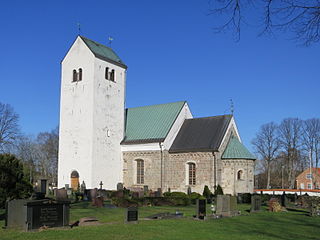
Vä Church, sometimes also called Saint Mary's Church in Vä is a well-preserved Romanesque church in Vä, in the southern Swedish province of Scania. It belongs to the Church of Sweden and is a listed building. It was built in the early 12th century, at a time when Scania was part of Denmark. The building was commissioned by a member of the Danish royal family, probably Queen Margaret Fredkulla. The church originally consisted of a nave, a chancel with an apse and two western towers. Quite soon after being finished, it was donated to Premonstratensian monks who used it as the church of their monastery until 1213. It simultaneously functioned as the parish church of Vä. At the end of the Middle Ages, a third tower was built, and in 1593 the building was enlarged. At the beginning of the 19th century, the western towers were demolished. A major restoration was carried out in the 1960s.
